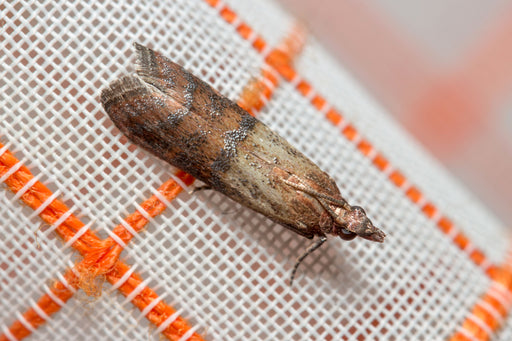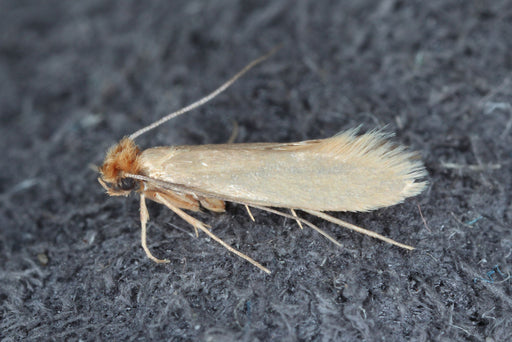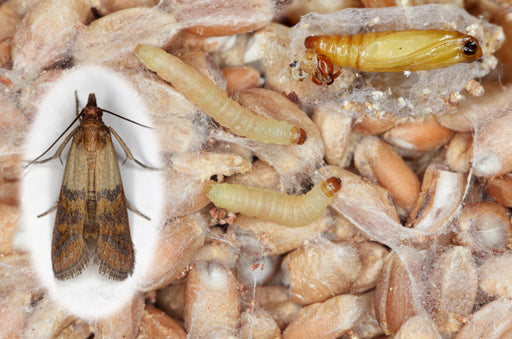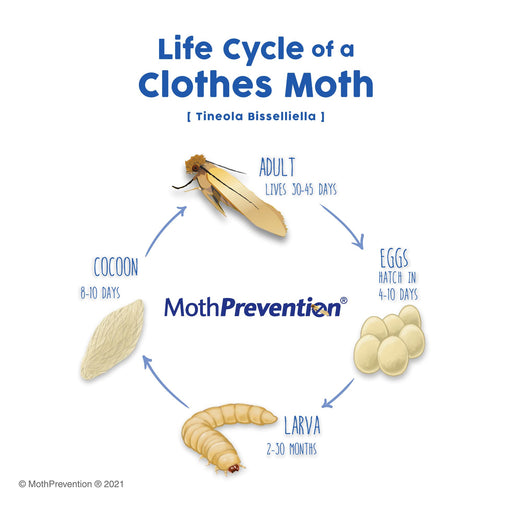Pantry Moths vs. Clothes Moths: The Differences That Matter

It’s like a scene from a horror movie: the flutter of wings in the moonlight of the kitchen; finding your favorite garments covered in holes; larvae found in the cracks and crevices of your home. A moth invasion, regardless of the type, is certainly a nightmare. And the nightmare may only get worse when you realize you have been using deterrents effective against a different kind of moth.
Save yourself from frustration. Learning the differences between clothes moths and pantry moths—two moth types that cause a lot of damage—will help you in the future when you need to decide which products or services can help you oust the pests.
What Do Pantry Moths Look Like?

Sometimes called Indian meal moths (Plodia interpunctella), a pantry moth is commonly found anywhere their favorite food (grains) are stored, particularly in the cupboard or pantry. These small moths have wings which are bronze or dark grey in color, while the upper half are a yellowy-gray color. Between the upper and lower segments of the wing is a noticeable black band. The wingspan is about 5/8 of an inch.
Infestation is often noticed rapidly, when larvae or adult moths are found in dry ingredient packages and containers.
What Do Clothes Moths Look Like?

There are two kinds of clothes moths that creep into your closet and make a mess of your most luxurious garments. Those would be the webbing moth (Tineola bisselliella) and casemaking moths (Tinea pellionella). Both kinds of clothes moths are very small, about less than a ½ inch long in many cases. The sole defining feature between webbing and casemaking moths is the coloring, where webbing moths are a solid whitish-gray while casemaking moths have darker brown or gray spots on the wings.
Since these moths are so tiny, you probably won’t notice there’s an infestation until you find damaged bedding or clothing or manage to see the tiny adults flying around the bedroom when disturbed.
What Do Pantry Moths Eat?
A pantry moth is going to be most at home in the kitchen, where they have access to a full range of sugars. This means they will ravage your dried pasta, flour, cereal, bread, grains, processed snacks, sugar, herbs and spices. Sometimes, pantry moths will even target dry pet food, dried fruits, and birdseed. Because pantry moths are attracted to loose grains and similar foodstuffs, you should never leave them unprotected.
Be sure to use airtight containers for your baking ingredients. Don’t leave grains and flours unwrapped.
What Do Clothes Moths Eat?
Clothes moths feed on the keratin—a protein found in natural fibers and hair. That includes things like silk, leather, wool, animal fur, pet and even human hair. Of course, a clothes moth will never attack people. No, they will remain in the dark and will eat whatever keratin they can find. Sometimes, clothes moth larvae will feed on threads and strands of hair that have collected in the corners of a room or along the baseboards.
Do not assume that synthetic fibers are safe from clothes moths either. The moths will find their way to whatever natural proteins are available, such as food stained garment awaiting a dry clean.
The Life Cycle of a Pantry Moth

An adult pantry moth can lay around 400 eggs, and those eggs can hatch within a week. This depends largely on temperature. The warmest months of the year are most dangerous for moth infestation, because eggs hatch faster, and the larvae grow rapidly. Once the eggs have hatched, the pantry moth larvae will eat everything in their path.
They will eat and eat and eat for about 2-3 months before maturing enough to pupate. The pupae move to places that you may not notice, such as corners of the pantry, behind furniture, or even beneath unused food.
Between 15-20 days, the pupa metamorphose into adult pantry moths. The adult’s sole purpose is to lay and fertilize eggs. So, the female immediately begins laying eggs on nearby food sources while the male works to fertilize those eggs. Then, the life cycle of the pantry moth continues anew.
The Life Cycle of a Clothes Moth

You might think that it’s the adult clothes moths who cause the most damage, but mature clothes moths don’t have mouths. Therefore, they cannot eat the fibers found in your garments. Rather, the larvae are the true menaces. That doesn’t mean the adults are faultless, since the female will lay around 300 eggs before perishing.
Those eggs then take between 8-10 days in the summer to hatch. Colder months cause the eggs to go dormant, so they may take months to hatch.
As soon as the larvae hatch, they launch into action, devouring the proteins in the fibers. While feasting, the larvae grow. This takes 1-3 months.
Once the larvae are prepared to pupate, they will release silk or webbing and attach themselves to somewhere safe. These silken cocoons are a sure sign of infestation. An adult moth will hatch from the cocoon within a few weeks.
To learn more about the life cycle of a clothes moth in detail, check out our blog.
How Do You Kill Pantry Moths and Clothes Moths?

So, in the pantry moths vs clothes moths battle, which one is harder to kill?
Ridding your home of moths means cleaning out the affected space, vacuuming, and using the correct trap for the moth you’re trying to catch. Keep in mind that, if you buy pheromone traps for pantry moths, the pheromones in the trap won’t attract and catch clothes moths. Conversely, clothes moth pheromone traps will attract and catch both clothes moths and pantry moths.
A pheromone trap for clothes moths is designed to attract and kill the male adults before they can reproduce. Traps are ineffective for killing eggs and larvae, so you’ll need moth killer kits suitable for the area you’re cleaning.
If you have a large or persistent infestation you may like to read our Pantry Moth Kit Guide or our Clothes Moth Kit Guide for information on using chemical products in line with our Traps to rid your home of moths.
Of course once the adult moths, larvae and eggs are removed the best way to keep them from returning is to make your house an arid landscape for a moth. Make sure your foodstuffs are sealed up in containers, your clothing is clean and protected - and hang traps to intercept the moths.
If you catch moths flying around, you may like to consider using natural moth repellents, such as cedar wood (there’s even been research on cedar repelling moths), lavender, cloves, thyme, and eucalyptus. Natural non-toxic methods are best particularly when you are trying to keep moths away from your stored food. However always use natural deterrents a good distance away from Moth Traps because they interfere with the Trap pheromones.
So, is it a Pantry Moth or a Clothes Moth?

Hopefully, you’re now armed with the information to figure out the differences between pantry moths and clothes moths. A clothes moth infestation is less noticeable—until you see damage done to cuffs, collars or seams on clothing.
Pantry moths—especially the adults—are stealthy, since they can blend into grains and hide inside food packets. You may notice the moth webbing and larvae wriggling through your food packets if you’ve got a keen eye or clear food storage containers. We highly recommend our powerful pantry moth traps for an easy solution.
Pantry moths are much more likely to be seen flying around looking for more food sources, meanwhile clothes moths tend to stay in one place.
Being able to figure out which type of moth is plaguing your home gives you a better chance of getting rid of them quickly. You can then select the correct pheromone trap and find and clean the area the eggs and larvae are calling home. Now, track down those moths then use our tips to get rid of them—quickly with our pantry moth traps.
About MothPrevention
MothPrevention® speak to customers every day about their clothes moth issues - clothes moths are a species that are ever increasing and that can cause significant damage to clothes, carpets and other home textiles.
To date, we’ve helped over 250,000 customers deal with their moth problems. We have developed professional grade solutions including proprietary pheromones and trap design, not available from anybody else in the USA.





